Related Research Articles

Qusay Saddam Hussein al-Tikriti was an Iraqi politician and the second son of Saddam Hussein. He was appointed as his father's heir apparent in 2000. He was also in charge of the Republican Guard.
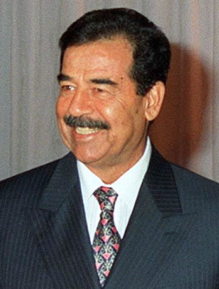
Saddam Hussein Abd al-Majid al-Tikriti was an Iraqi politician who served as the fifth President of Iraq from 16 July 1979 until 9 April 2003. A leading member of the revolutionary Arab Socialist Ba'ath Party, and later, the Baghdad-based Ba'ath Party and its regional organization, the Iraqi Ba'ath Party—which espoused Ba'athism, a mix of Arab nationalism and Arab socialism—Saddam played a key role in the 1968 coup that brought the party to power in Iraq.
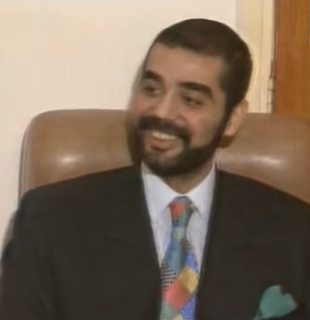
Uday Saddam Hussein al-Tikriti was an Iraqi politician, military officer and sports chairman who was head of the Iraqi Olympic Committee and Iraq Football Association and Commander of the Fedayeen Saddam.

Sajida Khairallah Talfah is the widow and cousin of former Iraqi President Saddam Hussein, and mother of two sons and three daughters. She is the oldest daughter of Khairallah Talfah, her husband's maternal uncle. She was played by Shohreh Aghdashloo in the BBC adaptation House of Saddam in 2008, in which her character played a major role.
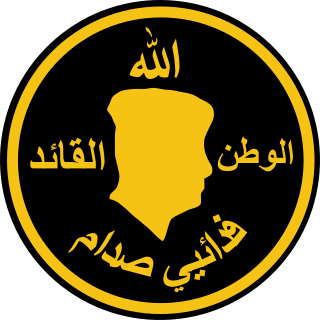
Fedayeen Saddam was a paramilitary organization loyal to the Ba'athist Iraqi government of Saddam Hussein. The name was chosen to mean "Saddam's Men of Sacrifice". At its height, the group had 30,000–40,000 members.

Sharif Ali Bin al-Hussein is currently the leader of the Iraqi Constitutional Monarchy political party and claims to be the legitimate heir to the position of King of Iraq, based on his relationship to the last monarch, the late King Faisal II.
Samira Shahbandar is a former flight attendant, and was the second wife of Saddam Hussein, and the mother of his third son.

Firdos Square is a public open space in central Baghdad, Iraq. It is named after the Persian word Firdows, which means "paradise". The site has been the location of several monumental artworks.

The trial of Saddam Hussein was the trial of the deposed President of Iraq Saddam Hussein by the Iraqi Interim Government for crimes against humanity during his time in office.

Al-Rusafa or Al-Rasafa is one of the nine administrative districts in Baghdad, Iraq, on the eastern side of the River Tigris. It is one of the old quarters of Baghdad, situated in the heart of the city, and is home to a number of public squares housing important monumental artworks.

The Monument to the Unknown Soldier is a monument in central Baghdad built by Italian architect Marcello D'Olivo based on a concept by Iraqi sculptor Khaled al-Rahal and constructed between 1979 and 1982. It was dedicated to the martyrs of the Iran–Iraq War. In 1986 the national square of Iraq, Great Celebrations square, was built near the monument, and two other monuments were built close to the square in memory of the matyrs. In 1983, the Al-Shaheed Monument on the River, was opened and in 1989 the newly built Victory Arch became the entrances to the square. The Unknown Soldier's Monument represents a traditional shield (dira¹a) dropping from the dying grasp of an Iraqi warrior. The monument also houses an underground museum.
Bassem Hamad al-Dawiri was an Iraqi sculptor and artist. He helped create a Baghdad artist association, called the "Survivors' Group" following the fall of the Saddam Hussein government in 2003.

Adnan Khairallah was Saddam Hussein's brother-in-law and cousin. He held several titles and was a member of the Iraqi Revolutionary Command Council. He also served as the Defence Minister of Iraq from 1979 to his death, having been appointed days after Saddam Hussein succeeded to the Presidency. He died in 1989 in a helicopter crash that was officially labeled an accident. The circumstances surrounding his death, including his disputes with Saddam and rumors of a potential coup have led some to believe Khairallah was assassinated under orders from Saddam.
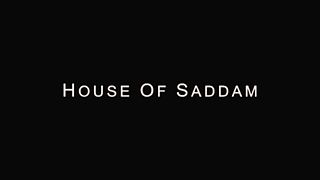
House of Saddam is a 2008 drama that charted the rise and fall of Saddam Hussein. A co-production between BBC Television and HBO Films, the series was first broadcast on BBC Two in four parts between 30 July and 20 August 2008.

A presidential referendum took place in Iraq on October 15, 1995. It was the first direct presidential election under the rule of Saddam Hussein, who had seized power through the Revolutionary Command Council (RCC) in 1979. Taking the form of a referendum with no other candidates, the election involved giving voters paper ballots that said: "Do you approve of President Saddam Hussein being the President of the Republic?" They then used pens to mark "yes" or "no". The next day, Izzat Ibrahim al-Douri, Hussein's deputy in the ruling RCC, announced the incumbent had won 99.96% of some 8.4 million valid votes cast. Officially, 3,052 people voted against him, and turnout was 99.47%. The international community reacted with widespread incredulity to these figures.
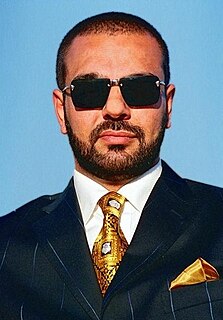
Latif Yahia is an Iraqi author and former combatant in the Iran–Iraq War. He is known for being the alleged former body double of Uday Hussein.

The destruction of the Firdos Square statue was an event in the invasion of Iraq in 2003 that marked the symbolic end of the Battle of Baghdad. The event occurred on April 9, 2003.
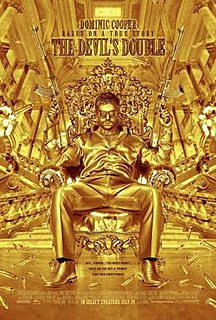
The Devil's Double is a 2011 English-language Belgian—Dutch film directed by Lee Tamahori, written by Michael Thomas, and starring Dominic Cooper in the dual role of Uday Hussein and Latif Yahia. It was released on 22 January 2011 at the 2011 Sundance Film Festival and was released in limited theaters on 29 July 2011 by Lionsgate and Herrick Entertainment.

The "Blood Qur'an" is a copy of the Islamic holy book, the Qur'an, claimed to have been written in the blood of the former president of Iraq, Saddam Hussein, over the course of two years in the late 1990s. Saddam commissioned the book in 1997 on his 60th birthday, reportedly to give thanks to God for helping him through many "conspiracies and dangers". He explained his reasons for commissioning the book in a letter published by the Iraqi state media in September 2000: "My life has been full of dangers in which I should have lost a lot of blood ... but since I have bled only a little, I asked somebody to write God's words with my blood in gratitude."

The 2003 Mosul raid was an American military operation conducted on July 22, 2003, in the city of Mosul, Iraq, which led to the killing of Uday Hussein and Qusay Hussein, both sons of deposed Iraqi dictator Saddam Hussein. The operation, originally intended to apprehend the Hussein brothers, turned into a four-hour gun battle outside a fortified safehouse which ended with the death of both Hussein brothers, a 14-year-old relative, and a bodyguard.
References
- 1 2 3 4 Bowen 2016
- 1 2 3 Agence France Presse (AFP) (May 27, 2005). "American icon: Iraqi powerlifter belches around Baghdad". sundaytelegraph. Retrieved 2007-07-25.
- 1 2 James Meek and Suzanne Goldenberg (March 19, 2004). "The day the statue fell". The Guardian . Retrieved 2007-07-25.
- 1 2 Lucas, Dean (2007). "Famous Pictures Magazine - Fall of Saddam Hussein's Statue". Famous Pictures Magazine. Retrieved 2007-07-16.
- Bowen, Jeremy (July 5, 2016). "Iraq Chilcot inquiry: Bitterness in Baghdad". BBC News . Retrieved July 7, 2016.